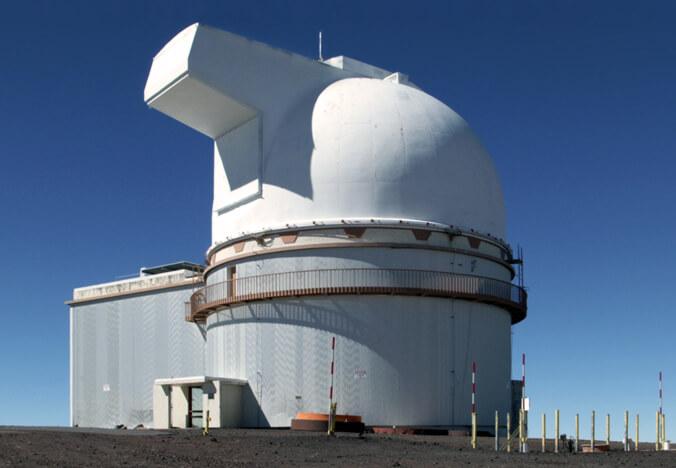‘Platform for groundbreaking discovery’: UH88 telescope honored as IEEE Milestone

In 1970, University of Hawaiʻi’s 2.2-meter telescope was dedicated at the summit of the Big Island’s 13,803-foot Mauna Kea, becoming the world’s highest and first computer-controlled telescope.
The innovations developed or tested by UH88, its nickname because 2.2 meters is 88 inches, have shaped astronomy worldwide. They include breakthrough digital imaging, adaptive optics and the HAWAII near-infrared detectors used on NASA’s James Webb Space Telescope.
UH88 was honored June 26 by Institute of Electrical and Electronics Engineers as an IEEE Milestone. It is a recognition of technological innovation and excellence for the benefit of humanity.
“This recognition speaks to the visionary work of University of Hawai‘i astronomers and engineers who transformed UH88 into a platform for groundbreaking discovery,” said Mark Chun, director of the telescope that still operates today. “For more than five decades, their innovations have not only shaped the telescope’s legacy but also helped push the boundaries of what’s possible in astronomy.”

In 1964, Gerard Kuiper, director of the Lunar and Planetary Laboratory at University of Arizona, was the first to propose placing a telescope on the summit of Mauna Kea. The exact location is 13,786 feet above sea level.
At that elevation, the telescope would be above much of Earth’s atmosphere and water vapor, providing a nearly complete view of the sky.
Physicist John Jeffries agreed with Kuiper and created a proposal for University of Hawai‘i to build and operate a facility for UH88 in Hawai‘i. After being awarded $3 million for his proposal in 1965, Jeffries founded University of Hawaiʻi Institute for Astronomy and began building the telescope and scientific research facility.

But it was a challenge to build at the summit, with snowy weather, no paved road and no electricity. Early researchers often traveled on off-road vehicles and slept in trailers at Hale Pōhaku, located at 9,200 feet above sea level. Some got stuck at the summit for days.
The state of Hawai‘i eventually built support buildings at Hale Pōhaku, a road and a power line, as well as provided government positions for astronomers and engineers. The decision to build at the site was quickly vindicated by the level of collection success, according to Institute for Astronomy.
During the dedication ceremony of the new observatory in 1970, Kuiper claimed the Mauna Kea summit to be the best site in the world to study space and the place where the most advanced observations from Earth can be made.

Ann Boesgaard and Alan Stockton, professors emeriti at University of Hawai‘i Institute for Astronomy; Robert McLaren, a former director of Institute for Astronomy; and Mark Rognstad, a professor emeritus of Hawai‘i Institute of Geophysics and Planetology, hosted a panel, shared old photographs and talked about the early days of UH88.
They were among the first researchers in the 1970s to study space from Mauna Kea and witnessed other observatories and telescopes follow UH’s lead to build on the summit. The first to join UH88 was Canada-France-Hawai‘i Telescope.
“The French were talking about going to Mexico with their telescope, but John Jeffries somehow convinced them to look at Mauna Kea,” Boesgaard said.
She remembers having a man from France, who would become the first director of that telescope, at her house: “He was so enthusiastic about the quality of the site. The French convinced the Canadians to commit to Hawai‘i.”

The Institute of Electrical and Electronics Engineers Milestone recognizes decades of innovation that has helped shape modern astronomy. Along with the facilities on Mauna Kea and Hawaiʻi Island, UH88’s legacy can be seen in observatories and space missions around the world.
“Every astronomy facility is based on the things that we’ve done in the past, the science that we’ve learned and the technology we’ve developed,” Chun said. “At the 88-inch telescope, you see that we’re part of that ecosystem, and that’s worldwide — ground-based telescopes, space telescopes — we played a big role in all of those.”
Some accomplishments include:
- Collection of data used to support Apollo missions to the moon;
- Study and discovery of dozens of Pluto-like objects;
- Discovery of the Kuiper Belt and distant objects beyond Neptune that led to the demotion and declassification of Pluto as a planet;
- Remaining a testbed for cutting-edge instruments such as next-generation infrared detectors and fully automated observing systems.
“Being named an IEEE Milestone underscores the world-class excellence of the University of Hawai‘i’s astronomy program,” said Institute for Astronomy Director Doug Simons. “It affirms that the innovation happening on Mauna Kea has global impact, from advancing how we explore the universe to training the next generation of astronomers right here in Hawai‘i.”

To commemorate this milestone, a bronze plaque was unveiled June 26 at UH88 on the summit of Mauna Kea, followed by a presentation and panel discussion at Institute for Astronomy on the University of Hawai‘i at Hilo campus.
UH88 is the first IEEE Milestone recognized on Hawai‘i Island and one of only a few statewide.
Other milestones in Hawai‘i include revolutionary wireless communication technology ALOHAnet, developed at UH Mānoa nearly 50 years ago, and the original electric lights at ‘Iolani Palace.



